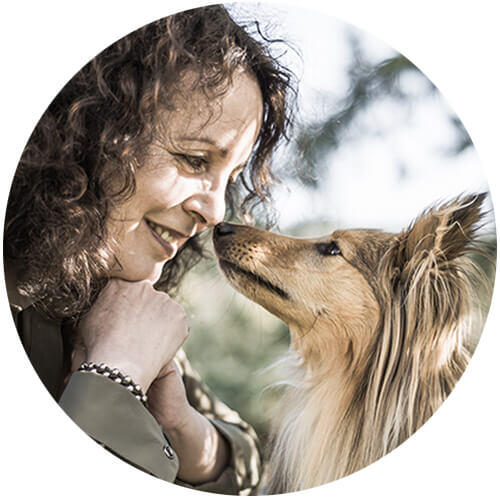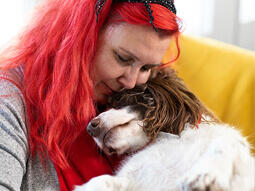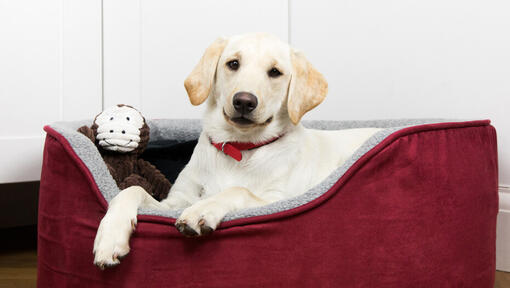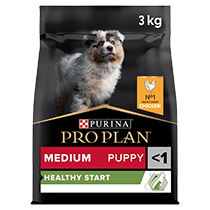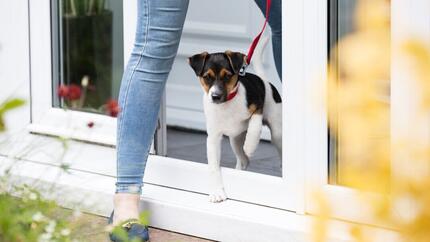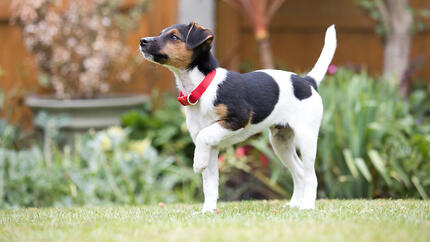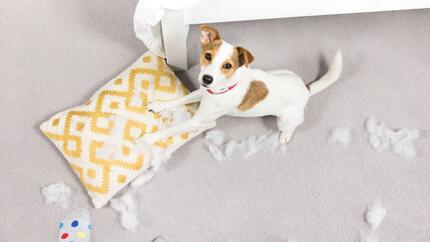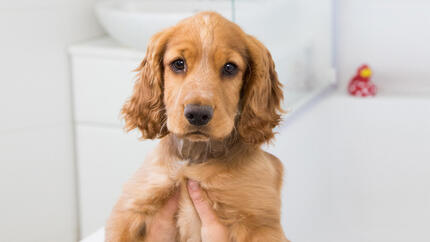

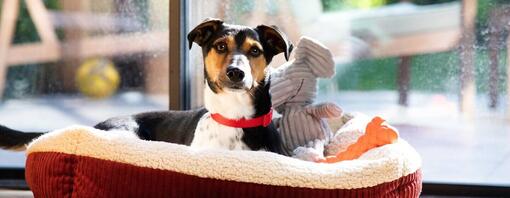
When you get a new puppy figuring out their sleeping arrangements can seem a little overwhelming. Find out the best puppy sleeping tips, options for puppy beds, how to manage those first few nights, and if you really should let them sleep in your bed with you.
Puppy sleeping arrangements
One of the very first decisions you are going to have to make – long before your puppy even comes home – is where they are going to sleep.
Puppies are growing fast and every day is a voyage of discovery, learning more about the world, their new family, and what this exciting new life holds. This rapid development is tiring, and new owners sometimes get so focussed on what their puppy is doing when they are awake, that they can forget that good, frequent and undisturbed sleep is just as vital for their physical, mental and emotional growth.
This isn’t always as simple as it sounds however – especially for the new owners who can get bogged down with conflicting advice from different sources who tell them where their puppy should sleep and how they should manage their first nights. There is so much advice out there that it can sometimes become exhausting, and difficult to establish what the best puppy sleeping arrangements should be. But that is why we have created a checklist full of the best puppy sleeping arrangements, and crate training advice just for you.
There is no doubt that in the light of new studies and research, views on this have changed in recent years - and so here is a guide to puppy sleeping arrangements.
Where should my puppy sleep?
The very best place for your puppy to sleep is in a crate or a puppy pen next to your bed. You can choose if you want to have them next to you in the bedroom, or if you want to set up a temporary bed next to wherever you would prefer them to sleep.
Most people choose the former - as sleep training - and the associated puppy toilet training - can take weeks and that’s a long time to camp out next to your puppy.
Thankfully we have come a long way from the days when we would shut a puppy in the kitchen overnight and leave them alone in the dark to cry themselves to sleep.
Now we are much more aware that an eight-week-old puppy is still a tiny baby - and they are suddenly on their own for the very first time in their life, away from their mum, their littermates, and everything that up until now has been familiar to them. Their new home is strange and unknown - as are these people - and so these early nights need to be about helping your new puppy settle in, feel safe - and begin to bond with you.
Puppies who are shut away from their new owners in these early days can easily go on to have separation-related behaviour problems as they have learnt from their very first night that people do leave them and it is really frightening and upsetting!
Some people like to have their puppy sleep in the bed with them – and if this is what you want, that is fine but you have to be really careful that they don’t fall off (unless you have a mattress on the floor), or that you roll on them – so in reality while it sounds idyllic, you will get virtually no sleep at all!
How long do puppies sleep?
When your puppy first comes home, they will usually sleep upwards of 20 hours a day, so they spend much more time snoozing than they do awake!
Sleep is incredibly important for your puppy as it aids healthy growth and contributes to the development of their central nervous system, brain, immune system and muscles, and it gives them a chance to process all the things they have learnt while they were awake.
An overtired puppy is just like an overtired human baby - fractious, restless and difficult.
During the day, you will find your puppy will suddenly crash wherever they are! Make sure they are undisturbed until they wake up again - full of energy and ready for another adventure.
Some puppies however won’t want to sleep if there is activity going on. Make sure you build nap times into their daily routine, and make sure this happens, so they are getting the sleep they need.
When do puppies sleep through the night?
If you manage the first couple of weeks well, it can happen surprisingly quickly - with some puppies sleeping through the night as early as 12 weeks old. Some however can take a lot longer (especially small breed puppies) so remember each pup is different and they all require your patience.
Remember that there is no easy answer to this but it is linked to their toilet training. Until puppies are able to go through the night without needing the toilet, you will be getting up in the middle of the night.
Even after this, they still need the security of your company to help them form a secure attachment.
What to expect on your puppy’s first night
On arrival in their new home, your puppy may take a while to settle in. This is likely to have been the first time they have been away from mum and their siblings. During the day, the activities of playing and sleeping might mean your puppy has been distracted and has not noticed that his previous doggy family are no longer around.
When it comes to night-time though, it's dark, long - and pretty boring! They don’t have their littermates there to keep them company - or even have a midnight game before falling asleep again - so the first few nights can be sleepless ones for you both.
Don’t be disheartened if the puppy sleeping arrangement plan you had created doesn’t quite go the way you expected. It is all a learned curve and it’s a time for you and puppy to learn how to navigate this new world.
New owners should fully expect to have disrupted sleep for a few nights or even weeks. Anything else is unrealistic and sets them and their puppy up for failure.
They are likely to need to go out to the toilet in the middle of the night (and small breed puppies might need to go out twice) and sleeping for eight hours without waking is very unlikely in such a young puppy. When they were with their mum and littermates, they would have woken up several times, maybe had a short game or just played a bit of lazy ‘bitey face’ before falling asleep again.
This means that your sleeping will be disturbed too. Plan your new arrival for a time when you can take this into consideration.
Puppy crying
On the first few nights, you can expect some crying or whining however, thankfully we have come a long way from the “shut them in the kitchen and let them cry till they fall asleep” thinking which was both unintentionally cruel and also can lead to attachment issues and potentially to separation related problems.
As your puppy will be beside you, you can soothe them with your voice and even put your fingers through the crate or play pen for comfort.
If they really won’t settle, it is likely they need to go out to the toilet, so take them out quietly without any interaction or games, wait until they have been to the toilet (remembering to reward them) and then take them straight back to bed to settle down again.
Make sure the crate or playpen is comfortable and warm, and ideally has something in it like a towel, blanket or piece of veterinary bedding brought home from the breeder that has familiar smells on it as this will help them settle.
You should find that after the first few nights sleeping beside you, puppy crying will be a thing of the past.
Lots of bathroom breaks
You’ll need to ensure that puppy gets out to the loo just before bedtime and it’s highly likely you’ll have to get up several times throughout the night too!
When you take your puppy out last thing, wait until they go to the toilet (and make sure you go with them so you know that they have actually done something and can reward them). Sometimes this takes patience as a young puppy can easily get distracted - no matter how much they wanted to go to the toilet!
Puppy first night checklist
- Set up your puppy’s sleeping area beside your bed long before you need it so you are not having to juggle a sleepy puppy at night
- A crate or a small play pen will keep them safe and secure while you can sleep easy knowing you will hear them if they wake up in the night and need a toilet visit. It will also help with toilet training - as a small sleeping area means they are more likely to try and avoid soiling their bed. They will be used to sleeping in an enclosed area with their mum and littermates, so this won’t be a new thing for them.
- Make sure there are no bits on the inside of the sleeping area that your puppy could injure themselves on.
- Some washable veterinary bedding makes a great comfortable bed - but including a cosy blanket and ideally something that has come from their first home will help make them feel more at home.
- Puppies do like to feel contained and secure so a very low sided, soft donut shaped bed can help with this - or just something soft they can burrow into. This is something they will grow out of quickly - or even chew on - so don’t spend a lot of money on this!
- Soft toys can sometimes be a comfort - but buy one that is specifically for dogs so you know it is safe.
- Make sure anything you put into the crate is safe - with nothing that can be eaten or swallowed.
- Before bedtime, have a gentle game with your puppy (if they are awake enough) and then take them out to the toilet. Have a tiny treat with you so you can reward them for going to the toilet in the right place. Be prepared to wait a long time if necessary - it’s easy for a puppy to get distracted - no matter how much they want to go to the toilet - and only remember when they get back inside!
- Then quietly go to bed - with your puppy in your ready-prepared sleeping area.
For the first few nights, you might find it works to set your alarm (quietly!) in the middle of the night so you can take them out for a toilet break - or else if you are a light sleeper, just wait until you hear them moving around and not settling again.
Like us, puppies sleep better when they are relaxed, comfortable and feel secure – and knowing that we are providing that for our dogs, means we can sleep easy too!
How to get a puppy to sleep at night without crying
1. Keep in mind how challenging this period is for your puppy
The first few nights are going to be a whole new experience for your puppy. They have never slept alone without their mum and their littermates to snuggle up to and give them comfort and security. They don’t know you or this strange new environment - and so to expect them to be happy to go to sleep for eight hours without a squeak is unrealistic - and very unlikely indeed.
2. Choose a comfortable bed for your puppy
You can make things easier for them by having a really cosy crate or pen with a bed or blankets they can snuggle up into - and ideally something that smells of home to help them feel more settled.
The advantage of them being beside your bed is that you can be there to give them comfort - and this is great to kick-start your bond as well.
3. Make sure you take them out to the toilet
For the first few nights, go to bed as late as you can manage and make sure your puppy has been out to the toilet (and you have gone with them so you can reward them, as always, for going to the toilet in the right place – and so they feel secure enough and relaxed enough to get down to business even though they are in a strange place in the dark).
4. Quietly go to bed
Expect your puppy to be unsettled, to take time to get comfortable - and to cry or squeak. Talk to them quietly and soothingly - and even put your fingers through the crate or pen as a comfort and to let them know you are there.
5. Don’t expect to get much sleep
Settle down with a good book if needs be and wait until they fall asleep.
Some puppies will sleep better with a bit of light, others with some gentle music - and others need the dark and the quiet. This is where you will begin to realise that each puppy is an individual and you are starting to learn about your new best friend.
If they cry in the middle of the night, talk to them again and hopefully, they will settle fairly quickly. If they don’t, it is likely they need to go to the toilet. Get up, quietly carry them to the toilet area (yes, you have to go with them!), wait until they go (not forgetting to reward them) and then go straight back to bed.
Don’t interact with them much on these toilet visits except to reward them when they go. If you play with them or make the toilet visit fun, they might well get into the habit of waking you up because they are a bit bored!
6. Refrain from punishing the puppy
No matter how tired you are, and how much you want to go to sleep, don’t punish your puppy in any way for nighttime crying.
The reality of life with a new puppy is that for the first couple of weeks, you are not going to get much sleep! If you manage these first weeks well and sensitively, you will have started that lifelong bond and trust between you - and the sleepless nights won’t last long.
A New Roommate
For those who remember the family dogs of their childhood, it might seem unexpected to be advised that the very best place for your new arrival to sleep is right beside you. Thankfully we know far more about dogs and how similar their emotions are to ours - and so we know how scary it will be for a puppy’s first nights away from their canine family to be spent alone, in the dark in a strange place.
By having them beside you, they will be happier to settle quicker, learn to sleep through the night far faster, and their toilet training will be much easier and quicker too.
It also has the added advantage that this will enhance the bond between you from the very start - and this will form the basis of a relationship that will last for life.
Troubleshooting the first nights at home with your new puppy.
While for most new owners - especially those who are prepared for what to expect - the early nights pass fairly incident free, what can you do if things don’t go entirely to plan?
Be realistic
First of all, expect sleepless nights for the first few weeks. This is the reality of having a puppy – this is not your puppy being difficult in any way. Also don’t underestimate how tiring that is going to be for you. Having a broken night’s sleep does take its toll and many new owners – especially if they are unprepared – find themselves hitting exhaustion point (or the “what have I done?” point). Be prepared for this – and arrange your days so you can take a nap in the middle of the day to catch up with sleep.
Make sure you are setting your puppy up to succeed
Your puppy is more likely to sleep if they are tired, so in the hour before bed, have a gentle game or play session. This shouldn’t be too active as you don’t want them hyperactive but you do want them ready for a snooze.
The advantage of doing this is also that movement and activity stimulate your puppy’s need to go to the toilet - so you have a better chance of them going to be ‘empty’!
Don’t make their final meal of the day too late
Don’t feed your puppy their final meal immediately or close to bedtime – otherwise, it won’t be long before they need to go to the toilet.
Go to bed as late as you can. Take them out to go to the toilet last thing before bedtime so you know that the need to pee or poo will not keep them awake. Be prepared to wait until you know your puppy has gone to the toilet (and of course has been rewarded for doing so). This can take some time, as puppies can get distracted by the great outdoors and forget what it is that they are out there for so be patient!
Straight to bed
Having made sure that you are ready for bed beforehand and straight after the last toilet visit, you can put your puppy in the crate or pen beside you – and immediately go to sleep (or pretend to go to sleep) so your puppy doesn’t think there is a chance of more playtime!
On the first night with the new puppy, you might notice them squeaking or even barking – as their body clock isn’t in a routine yet and night-times are a bit boring! You can soothe them with your voice – and even put your hand on the crate – but give them the space and the time to settle down.
While you can comfort your puppy in this way, don’t be tempted to get them out and cuddle them or play with them – otherwise, they have just learnt the perfect way to make night times more fun and so will be even more persistent in trying to get your attention!
Provide distractions for restless pups
If they really won’t settle (and you really have been patient about this!), you can put a Kong toy with something tasty and puppy-appropriate smeared around the edge and inside, to encourage them to chew. This will distract from the crying or whining but also relax and tire the puppy so they are more likely to fall asleep.
Give them a comfort blanket
Having something like a blanket or a towel in the crate that smells of their mother and littermates can often help them feel secure and so sleep better. Give something to the breeder when you visit the puppies and ask them to keep it in the puppy pen until you bring your puppy home for the first night sleep.
Get a small doughnut bed
Some puppies feel more secure when they can tunnel into a bed or be surrounded by soft sides (think about how they sleep bundled up with their littermates in a puppy pile) so consider getting a small, low-sided doughnut bed to put in the crate.
Don't make toilet time fun time!
If you do have to get up in the night to take them outside to the toilet (as you may well in the first couple of weeks), make this as boring as possible with no interactions beyond rewarding successful toileting.
Start from the start
It is way too late to tell you this but ensuring you get your puppy from a breeder who rears in the home and so who has puppies that are already used to a domestic sleep/wake routine, and to being in a puppy pen, will make the puppy’s first nights so much easier.
Breed considerations
In the majority of cases, toy dog breeds and tiny dogs are harder to toilet-train. There are a variety of reasons for this. Often breeders keep them longer before they go to their new homes, and unless they have prioritised toilet training with each puppy individually, they will not have got into good early toilet training habits or be used to sleeping alone. Plus, the amount of pee and poo from a toy breed isn’t much and so there isn’t quite the same incentive to get toilet training right early on as the clean-up operation isn’t that taxing!
Also, the bladder and digestive system of a toy dog are minute – and so they need to go to the toilet far more frequently… something new owners often totally underestimate. So, they have more accidents – and more accidents mean that toilet training takes longer.
If you have a toy breed puppy or any small dog, you need to be even more patient, take them out far more frequently both during the day and at night, and as always make sure you reward every success with a very tiny treat.
Lifestyle considerations
Not everyone lives in a house with a garden right outside the back door – and so if you live in a flat or somewhere without a garden, your job is a bit harder.
You have a range of choices. The first –and the best – is that you over-anticipate your puppy’s need to go to the toilet, and carry them to wherever the nearest safe place your puppy can use as a toilet.
Do remember that they are not vaccinated and so this has to be a place where you can be certain there is no access by any dog whose vaccination history you are not 100% confident about. This will include during the night too – which can be quite exhausting. If you choose to do this, it can make things easier if you sleep in your clothes or if you sleep in something you don’t mind your neighbours seeing you in!
In certain countries around the world where space is a premium, many people litter train their puppies the same way they do their kittens. This is an option – especially with toy breeds. For other people putting pee pads down in one corner of the house (out of the way of children, food etc) and using that for toilet training can work remembering your aim is to lengthen the time between toilet breaks so the puppy learns to wait for longer as they get older and rewarding every success so giving them constant access to that won’t be helpful. In time, you can move that training to the outside but it does mean it will take longer and can be confusing for your pup.
Perhaps the best answer however is to rehome an older dog from a rescue organisation who is already toilet trained.
Daytime puppy sleeping arrangements
During the day your puppy needs plenty of opportunity to be able to sleep too. Puppies have bursts of energy followed by frequent naps to recover – so they need somewhere comfortable and quiet to sleep, while still being close to you. You can set up a crate or a playpen with soft veterinary bedding in every room you are likely to spend time – or more likely you can get a bed to put in a quiet area of the room, as you will be there to supervise daytime napping.
- Make sure any bed you buy is safe with nothing that can be chewed or swallowed easily.
- Have something soft, cushioned, warm and easy to get in and out of – no steps or high sides, which can strain, injure or damage immature joints, bones and muscles/ligaments.
- Puppies like to feel contained and secure – so if you are buying a cosy dog bed buy something small and replaceable rather than something huge that your puppy will eventually grow into. There’s time for a beautiful expensive bed when your puppy is all grown up, toilet-trained and less likely to chew!
- Don’t tell your puppy off for chewing the bed. They’re only a baby and that’s what babies do. When you see them doing it, give them something appropriate to chew on instead to try and break the habit.
- Put the bed/crate in a quiet part of the room where the puppy will not be disturbed by people coming in and out but still close to you – and make a hard and fast rule that no one disturbs the puppy when they are sleeping.
- Something waterproof underneath the bed (a cut-open bin liner and newspaper will do the job) can be useful in case of toilet training accidents but you should be supervising these times to ensure your puppy doesn’t get the chance to make a mistake – especially as the first thing a puppy needs to do when they wake up is go to the toilet!
Benefits of a dog bed
There are many benefits to having a dog bed, more so for your dog than anything else of course, those are:
Any good dog bed will provide your dog with a soft place to rest after a long day of activity and fun. As dogs move into their senior years, this becomes more important.
Dog beds can help keep your dog warm, which is especially important during the winter when the bed keeps your dog from direct contact with the cold floor.
Just like most people, your dog will sometimes want a place to relax while they are on their own. A comfortable dog bed allows your dog to get some alone time when they need it.
Other considerations when choosing a dog bed for your growing pup
Puppy beds need to give ample room for the growing pup, and if you're using them inside a puppy crate or pen, be able to fit comfortably inside. If you’ve ever looked at your dog while they are sleeping, then you’ve probably noticed that dogs can sleep in various positions: on their back, on their side, curled up or stretched out. It’s important to take this into consideration when choosing which dog bed is right for your dog.
It’s very important that the dog bed you choose allows your dog to move around comfortably while staying within the confines of the bed (even if they choose not to). If the bed is big enough for your dog to lie in while curled up, but too small to fit in with their limbs fully outstretched, then your dog might become uncomfortable or cold.
Where should I put my dog’s beds?
Your dog needs a bed in any room they are going to be relaxing with you in or sleeping in. Some dogs also like to have one away from the hustle and bustle of family life when they want some ‘alone time’.
It’s best to put your dog’s beds in a part of the room that is warm and free from draughts.
You also want to put the beds somewhere you dog won’t be disturbed by family members (so not in hallways or beside doorways) - and won’t be distracted by noise from outside the house.
You might also want to have multiple dog beds in the house so your dog can choose where they sleep. For example, a dog bed in a quiet part of the house could be nice for your dog when they want some alone time, but also putting a bed in the living room can be perfect when your dog wants to rest near their family.
Puppy Crate Training
If you want your new puppy to be close to you and therefore you want them to sleep in the same room as you, we would suggest setting up a bed for your puppy beside yours. An indoor puppy crate can be invaluable here as it means your puppy can be beside you but still be safely contained so both of you have a chance to get some sleep – and your puppy begins to learn that night times are for settling down and sleeping.
It also simplifies toilet training as the puppy won’t want to soil the area where they sleep (their mum has already taught them that) and so they can’t sneak off to a corner of the room. It does mean you have to be ready to take them out when they wake up however - as you don’t want them to get distressed from needing to go and having to hold on.
Line the puppy crate with veterinary bedding (which is warm, comfortable and washable) and ideally include something that came from the breeder such as a blanket that smells of mum and security.
While for now, your puppy’s place is beside you, an advantage of a puppy crate is that once your puppy is settled, you can gradually move this to wherever you ultimately want your puppy to spend the night. They do not have to stay in the bedroom forever (unless you want them to of course) - but for now, they need the comfort of being beside you.
The puppy will have the comfort of your presence, you are beginning the bonding process and building trust, and even better, you will know if your puppy wakes and needs to go out to the toilet – which will make your toilet training even quicker and easier too.
How to Crate Train a Puppy
Crates can be a scary thing for a new puppy, especially if they have never been in one, or seen one before. Try to create a positive association with the crate, with the use of treats and fun play times. Don’t loose your patience, crate training can take up to 6 months to master. Make sure you choose the right crate for your puppy; you want to choose a crate that has the right balance between space and security. You don’t want a crate that is too small, but you also don’t want a crate that is too big, the crate to symbolise a safe space for your pup.
Stay calm, cool and collected when trying to get your dog into the crate, it easy to lose faith, but trust the process, your dog will react more positively to a relaxed mindset. Set your dog up gradually, pop them inside the crate for a few minutes at a time and reward them for successful crate time.
Alternatives to puppy crates
Night Time
If you choose not to use a puppy crate, have a soft, warm, safe bed that you can put on the floor beside you but set up a play pen or a barrier around it so your puppy is more likely to settle down and sleep – and so get into a sleeping routine – and can’t wander off, chew things, play, or use various parts of your bedroom as a toilet! This keeps your puppy safe – and means you don’t stay awake all night worrying about what they are doing!
Day Time
During the day your puppy needs plenty of opportunity to be able to sleep too.
Puppies have bursts of energy followed by frequent naps to recover – so they need somewhere comfortable and quiet to sleep, while still being close to you. You can set up a crate or a playpen with soft veterinary bedding in every room you are likely to spend time – or more likely you can get a bed to put in a quiet area of the room, as you will be there to supervise daytime napping.
Many people do not like the idea of using a puppy crate – and there is no doubt they can be misused by people who use them as a way to shut their dog away for hours on end – but used properly, a crate is an invaluable training aid that can help you keep your puppy safe, simplify your toilet training, and make sure you both get some sleep in those early days of your life together.
It is vitally important that you do it right though – and thankfully very simple.
1. Get the right sized crate
First of all, make sure you get a crate the right size for your puppy – and this may mean you upgrade it several times as your dog grows. Sometimes if you visit local social media groups, you can find people who might even be able to lend you one for a short time. Having two crates to start with can help too (then you don’t have to move it around!).
At all times, the crate should be big enough that your puppy can stand up comfortably, lie stretched out and be able to get up and turn round. It shouldn’t be so big however that they can use one end for sleeping and the other end as a toilet!
2. Make the crate really comfortable
Line it with veterinary bedding that goes up the sides to keep the pup warm and comfortable. You can also use blankets, old duvets, or a small, low sided donut-shaped bed.
3. Introduce the crate
Then introduce it slowly the crate to your puppy. This is really important. On your puppy’s first night, you can’t just stick him in there and expect him to be happy about it - however most puppies are used to sleeping in a puppy pen with their mum and littermates, and so this isn’t going to be too new for them.
You can do this during the day - and when you are playing with the pup, encourage them to go into the crate by their own choice – possibly to chase a toy, or to get a treat. You are teaching them that the crate is a safe and rewarding place to be. Don’t shut the door yet!
4. Feed your puppy their meals in the crate
Put your puppy’s meals in the crate - and while they are eating you can push the door over for a few minutes.
Whenever the pup is sleepy, put them in the crate beside you, so they feel comfortable about sleeping in there.
Make a hard and fast rule that no-one ever disturbs the puppy when they are in the crate. It’s important especially on the first night with the new puppy to teach them that this is their safe haven away from the craziness of their new life where they can totally relax.
Always stay close by and where your puppy can see you, so your puppy doesn’t feel abandoned or ‘locked away’ from you.
5. Start letting them sleep in the crate
Once the puppy is happy and relaxed about sleeping in the crate and going in and out of it, they can be put in there to spend the night – and for most pups this doesn’t take long at all and they should be ready on the first evening.
Thankfully many breeders will have already crate trained their puppies (as it is a lot easier for them not to have puppies running riot around their house) and this will make things so much easier for you and allow you to start as you mean to go on – so it may well be something you want to ask the breeder right at the very start.
Every pup is different though and so you need to be sensitive to your own dog and not rush this.
Remember, the crate is a place of safety and security designed to help you manage the puppy’s early nights at home – it is not something to use for long periods of time.
A crate is to be used to keep your puppy beside you - not to lock them away from you. This is how a crate can be misused and why some people are very anti-crates!
Your puppy should spend their life out and about with you, learning about this new world and bonding with you – not shut in a crate!
NOTE: If your puppy wears a collar in the house, always take it off before you put them in the crate.
Knowing the right steps to take and getting them right the first time can take time, patience, energy and a few sleepless nights. Before you know it, however, your puppy will be sleeping comfortably through the night – and so will you!
If you want to read up on more ways to prepare for your new puppy, then take a look at our article on preparing for a new puppy.
